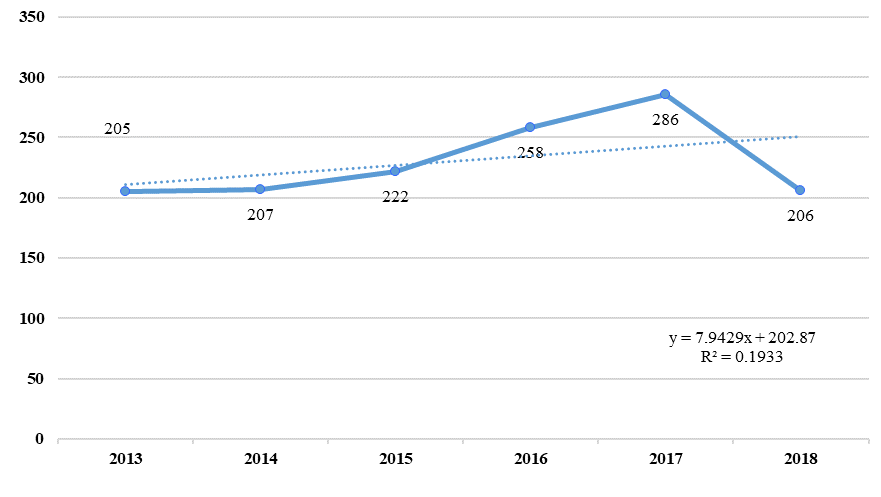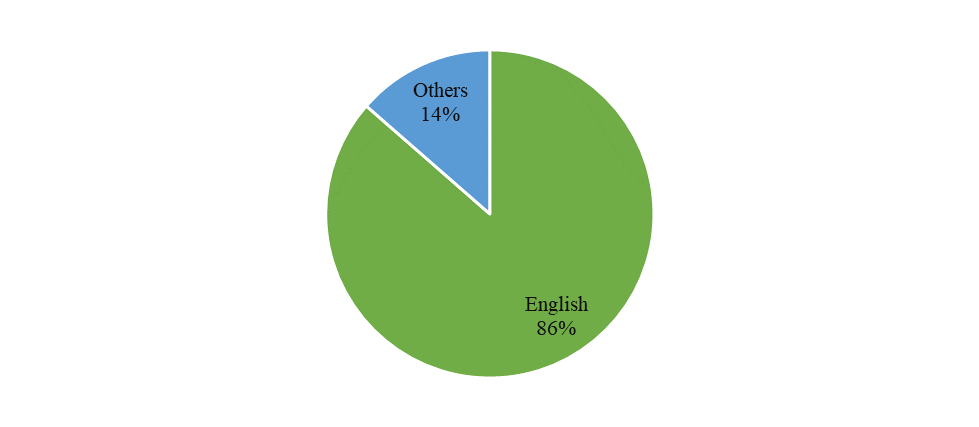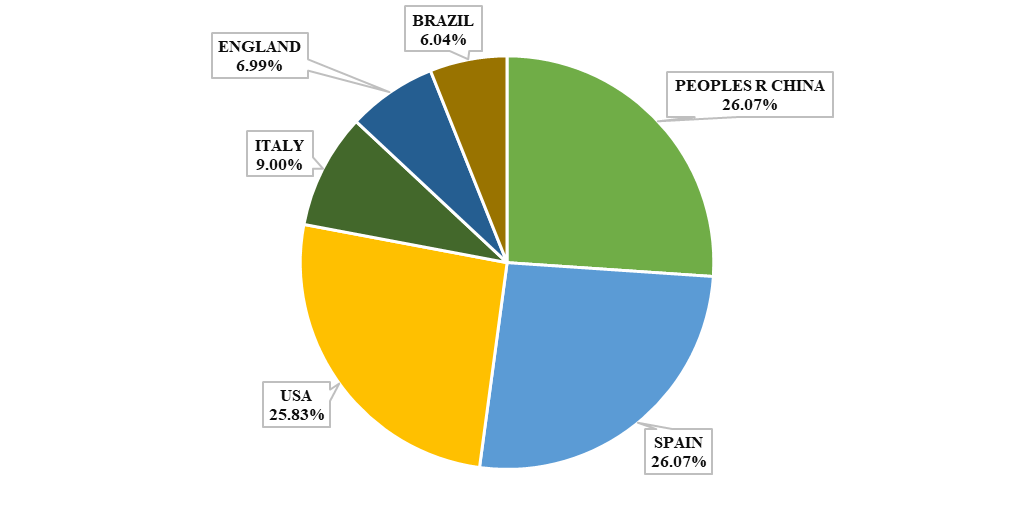Abstract
Teaching has been centred on teaching knowledge and contents, but recently, different professionals have changed their teaching procedures. The attention is more on innovation as a means to improve the teaching-learning processes. Today, society in general, but especially the new generations, are developing a close relationship with the technology that surrounds them. For the case analyzed, the period between 2013 and 2018 was taken into account. Undoubtedly, new technologies have influenced the quality and quantity of teaching, learning and research in educational institutions. The collection of data is based on articles published in scientific journals indexed in WoS (Web of Science), being the database with the highest international scientific recognition During the research carried out, a bibliometric analysis was made available around innovative methodologies in the field of education. Bibliometric is one of the most important measures for the evaluation of scientific productions. Bibliometric indicators have become essential for the scientific community to estimate the state of the art of a field. Results show a growth of this type of research in recent years. In addition, shows a growth trend in this type of research, both in articles and in meetings. It also shows the predominance of the English language in the international scientific field. Regarding the gender, the male authors stand out with respect to women.
Keywords: Bibliometricsinnovationmethodologymethodseducational
Introduction
Traditionally, teaching has been centred on teaching knowledge and contents. Recently, different professionals have taken their teaching procedures to another level, thus guiding their teaching method on the consecution of key competences, as it is reflected in the Spanish educational law ( Ley Orgánica para la mejora de la calidad educativa, LOMCE, 2013). Teachers have been working on them since them in their classes.
Some researchers also started to work on this, not only with students, but also with teachers. Teacher training and activities have been concentrated more on learning and knowledge and less on learning to live or on being and doing. In a research by Palomares ( 2014) the aim was to foster the emotional competence of future teachers offering experiences on the importance of a more reflective, ecological and credible professional development.
Ascione, Di Palma and Rosa ( 2019) also believe in supporting the experimentation of new and integrated educational methods to promote the development of knowledge.
Therefore, something is changing in the way education is been understood nowadays. Students have to learn how to learn, they have to learn by doing and they have to build their knowledge ( Rodríguez García & Ramírez López, 2014).
But not only researchers have focused on how the students learn, some of them have focused on the essence of innovations and the application they have in teaching in connection with the student’s educational outcomes ( Kolomiets & Litvinova, 2019).
Many researches work on different ways of innovation as a means of learning. Thus, Vaquero, and Lorenzo ( 2009) in their research analyzed an innovative experience related to a collaborative learning methodology in the postgraduate training of nursing professionals. Serrano Marugán, Palomares Ruiz, and Garrote Rojas ( 2013) also worked on analyzing types of schooling innovations, which are used to give an inclusive attention to students with visual disability. Therefore, we can see that educational innovation is related to the needs we can find, the need to improve and learning itself as it is seen in several researches ( Henderson, 2008).
The use of effective strategies of learning depends on several aspects, and one of them is the students’ motivation, which is understood as something that directs people toward the goals ( Pintrich & Schunk, 2006).
Nowadays, as a reaction to the problems found about teachers’ and students’ demotivation, the social, political and technological changes, there is a change among the teaching methods. Among the innovative methodologies most used in class we can find gamification ( De Freitas, 2018; Deterding, Dixon, Khaled, & Nacke, 2011; Lister, 2015; Werbach, 2014), problem-based learning ( Mookherjee & Cosgrove, 2005; Overton, 2016), project-based learning ( Reitmeier, 2002; Willard & Duffrin, 2003) or flipped learning ( Sánchez, 2017; Seery, 2015; Zainuddin, Habiburrahim, Muluk, & Keumala, 2019). Through these innovative ways of teaching and learning, the active participation of the student is promoted, so that their learning is meaningful outcomes ( Kolomiets & Litvinova, 2019).
Problem Statement
This work is dedicated to know and analyse the scientific literature available around innovative methodologies in order to analyse their production and provide researchers with possible ways of studying.
Research Questions
Following similar research, the research questions are extracted the classic research questions for this type of studies ( Arguimbau-Vivó, Fuentes-Pujol, & Gallifa-Calatayud, 2013; Sánchez & Blanco, 2016):
RQ1. What is the diachronic growth of the methodologies?
RQ2. What is the main language of publication?
RQ3. Which magazines and meetings are the biggest producers?
RQ4. Which are the most productive authors and their gender?
RQ5. Which are the most productive countries?
Purpose of the Study
The purpose of this study is to know and analyse the scientific literature available around innovative methodologies in order to analyse their production and provide researchers with possible ways of studying.
Research Methods
During the research, a scientometric analysis was conducted around innovative methodologies in the field of education. Scientometrics is one of the most important measures for the evaluation of scientific productions. Scientometric indicators have become essential for the scientific community to estimate the state of the art of a given topic ( Sanches-Marques, Lolis, Arruda Reis, & Benedito, 2009).
In this research, the period taken into account between 2013 and 2018. The data collection is based on articles published in scientific journals indexed in WoS (Web of Science), being the database with the highest international scientific recognition ( Jiménez Noblejas & Perianes Rodríguez, 2014), the rest of the documents found, such as papers, reviews, or books are discarded from the results.
Procedure
The search for the documents was conducted in two phases. In the first one, an exploratory search is carried out using keywords (Table
Findings
We present the results obtained during the study of the literature on innovative methodologies with respect to each of the research questions that we propose
Diachronic growth of the methodologies
As shown in Figure

Language of publications
When we make an analysis of the scientific literature, another of the fundamental aspects that must be analyzed is the language in which they are developed. As shown in Figure

Accumulation according to journals
The results, shown in table
Accumulation according to key authors
Usually we can see scientific knowledge around a specific topic in different key authors. Lotka ( 1926), who showed that there are few authors where high production is concentrated while the rest, the bulk of the research is centered on authors who publish on the subject in a timely manner, already described this effect.
As shown in table
Accumulation according to country

Conclusion
We must make reference to that not always the little production detected in this type of analysis is directly related to a low scientific interest, but it can be due to other factors such as the development of technology or conceptual youth in the field studied ( Wang, 2018).
Regarding the language in which they develop most of these productions or scientific knowledge is the English language. Although there are other large science producing countries such as China or Spain, the obligation to publish in both languages means that, in one way or another, all the research generated is shared in English, relegating Spanish and other languages to a second level. This phenomenon is caused by the penalties of the databases themselves, in this case the WOS, to non-English languages ( Aleixandre Benavent, Valderrama Zurián, Miguel-Dasit, & de Granda Orive, 2004; Ramakrishnan, Sankar, & Thavamani, 2018).
There is also a gender gap. We find many career researchers, but few women in academic leadership positions, as principal investigators ( Bendels et al., 2018). However, this gender gap has narrowed in the last decade and is likely to be further reduced in the future ( Campos-Castillo, 2015).
References
- Aleixandre Benavent, R., Valderrama Zurián, J. C., Miguel-Dasit, A., & de Granda Orive, J. I. (2004). El factor de impacto de Revista Iberoamericana de Micología [Impact factor of Revista Iberoamericana de Micología]. Revista iberoamericana de micología, 21, 161-167.
- Arguimbau-Vivó, L., Fuentes-Pujol, E., & Gallifa-Calatayud, M. (2013). Una década de investigación documental sobre cienciometría en España: análisis de los artículos de la base de datos ISOC (2000-2009) [A decade of documentary research on Scientometrics in Spain: analysis of the articles in the ISOC database (2000-2009)]. Revista española de Documentación Científica, 36(2), en007. httpa://doi.org/10.3989/redc.2013.2.907
- Ascione, A., Di Palma, D., & Rosa, R. (2019). Innovative educational methodologies and corporeity factor. Journal of Human Sport and Exercise, 14(2proc), S159-S168. https://doi.org/10.14198/jhse.2019.14.Proc2.02
- Bendels, M., Dietz, M., Brüggmann, D., Oremek, G., Schöffel, N., & Groneberg, D. (2018). Gender disparities in high-quality dermatology research: a descriptive bibliometric study on scientific authorships. BMJ Open, 8(4), e020089. https://doi.org/10.1136/bmjopen-2017-020089
- Campos-Castillo, C. (2015). Revisiting the first-level digital divide in the United States: Gender and race/ethnicity patterns, 2007–2012. Social Science Computer Review, 33(4), 423-439. https://doi.org/10.1177/0894439314547617
- De Freitas, S. (2018). Are Games Effective Learning Tools? A Review of Educational Games. Journal of Educational Technology & Society, 21(2), 74-84.
- Deterding, S., Dixon, D., Khaled, R., & Nacke, L. (2011). From game design elements to gamefulness. Proceedings of the 15Th International Academic Mindtrek Conference on Envisioning Future Media Environments - Mindtrek '11. https://doi.org/10.1145/2181037.2181040
- Henderson, C. (2008). Promoting instructional change in new faculty: An evaluation of the physics and astronomy new faculty workshop. American Journal of Physics 76(2), 179-187.
- Jiménez Noblejas, C., & Perianes Rodríguez, A. (2014). Recuperación y visualización de información en Web of Science y Scopus: una aproximación práctica [Information retrieval and visualization in Web of Science and Scopus: a practical approach]. Investigación Bibliotecológica: Archivonomía, Bibliotecología E Información, 28(64), 15-31. https://doi.org/10.1016/s0187-358x(14)70907-4
- Kolomiets, O. M., & Litvinova, T. M. (2019). Teaching activities in higher medical school: innovations and management features. International Journal of Educational Management, 33(4), 651-662.
- Ley Orgánica para la mejora de la calidad educativa, LOMCE (2013). Ley Orgánica 8/2013, de 9 de diciembre, para la mejora de la calidad educativa. Boletín Oficial del Estado, 295, de 10 de diciembre de 2013.
- Lister, M. (2015). Gamification: The effect on student motivation and performance at the post-secondary level. Issues and Trends in Educational Technology, 3(2). https://doi.org/10.2458/azu_itet_v3i2_Lister
- Lotka, A. J. (1926). The frequency distribution of scientific productivity. Journal of the Washington Academy of Sciences, 16(12), 317-323.
- Mookherjee, S., & Cosgrove, E. (2005). Handbook of clinical teaching. Las Vegas: Springer.
- Overton, T. (2016). Context and problem-based learning. New Directions in The Teaching of Physical Sciences, (3), 7-12. https://doi.org/10.29311/ndtps.v0i3.409
- Palomares, A. (2014). Metodologías innovadoras para promover las competencias emocionales de los docents [Innovative methodologies to promote the emotional competences of teachers]. Journal for Educators, Teachers and Trainers, 5(2), 116 – 129.
- Pintrich, P. R., & Schunk, D. H. (2006). Motivación en contextos educativos. Teoría, investigación y aplicaciones. (2nd edition) [Motivation in educational contexts. Theory, research and applications. (2nd edition)]. Madrid: Pearson Prentice Hall.
- Ramakrishnan, J., Sankar, G. R., & Thavamani, K. (2018). Analysis of literature on dengue: a bibliometric study. Library Philosophy and Practice, 1-19.
- Reitmeier, C. A. (2002). Active learning in the experimental study of food. Journal of Food Science Education, 1, 41-44.
- Rodríguez García, A. B., & Ramírez López, L. J. (2014). Aprender haciendo-Investigar reflexionando: Caso de estudio paralelo en Colombia y Chile [Learn by doing-Investigate by reflecting: Case study in Colombia and Chile]. Revista Academia y Virtualidad, 7(2), 53-63.
- Sanches-Marques, A., Lolis, S., Arruda Reis, S., & Benedito, E. (2009). Scientometric analysis of energetic ecology: primary production of aquatic macrophytes. Acta Scientiarum. Biological Sciences, 31(4). https://doi.org/10.4025/actascibiolsci.v31i4.5139
- Sánchez, C. (2017). Flipped classroom. La clase invertida, una realidad en la Facultad de Ciencias de la Educación de la Universidad de Málaga (Doctoral Dissertation). Universidad de Málaga, España. Retrieved from https://riuma.uma.es/xmlui/bitstream/handle/10630/14993/TD_SANCHEZ_ CRUZADO_Cristina. pdf?sequence=1&isAllowed=y
- Sánchez, L., & Blanco, B. (2016). Análisis de la producción científica hispana en mejora continua: 1990-2011 [Analysis of Hispanic scientific production in continuous improvement: 1990-2011]. Revista española de Documentación Científica, 39(1), e116. https://doi.org/10.3989/redc.2016.1.1264
- Seery, M. K. (2015). Flipped learning in higher education chemistry: emerging trends and potential directions. Chemistry Education Research and Practice, 16(4), 758-768. https://doi.org/10.1039/c5rp00136f
- Serrano Marugán, I., Palomares Ruiz, A., & Garrote Rojas, D. (2013). Propuestas innovadoras para favorecer el uso de las TIC y propiciar la inclusión educativa del alumnado con discapacidad visual [Innovative Proposals To Encourage The Use Of The Ict And Promote The Educational Inclusion Of Visually Impaired Students]. ENSAYOS, Revista de la Facultad de Educación de Albacete, 28, 61-74.
- Vaquero, Á., & De Lorenzo, E. (2009). La satisfacción del alumnado en la implementación de metodologías colaborativas de aprendizaje [The satisfaction of the students in relation to the implementation of collaborative learning methods]. Index de Enfermería, 18(2), 142-146. Retrieved from http://scielo.isciii.es/scielo.php?script=sci_arttext&pid=S1132-12962009000200018&lng= es&tlng=es
- Wang, Q. (2018). A bibliometric model for identifying emerging research topics. Journal of the association for information science and technology, 69(2), 290-304. https://doi.org/10.1002/asi.23930
- Werbach, K. (2014). (Re)Defining Gamification: A Process Approach. Persuasive Technology, 266-272. https://doi.org/10.1007/978-3-319-07127-5_23
- Willard, K., & Duffrin, M. W. (2003). Utilizing project-based learning and competition to develop student skills and interest in producing quality food items. Journal of Food Science Education, 2, 69-73. Retrieved from https://onlinelibrary.wiley.com/doi/pdf/10.1111/j.1541-4329.2003.tb00031.x
- Zainuddin, Z., Habiburrahim, H., Muluk, S., & Keumala, C. M. (2019). How do students become self-directed learners in the EFL flipped-class pedagogy? A study in higher education. Indonesian Journal of Applied Linguistics, 8(3), 678-690. https://doi.org/10.17509/ijal.v8i3.15270
Copyright information

This work is licensed under a Creative Commons Attribution-NonCommercial-NoDerivatives 4.0 International License.
About this article
Publication Date
27 May 2020
Article Doi
eBook ISBN
978-1-80296-083-9
Publisher
European Publisher
Volume
84
Print ISBN (optional)
-
Edition Number
1st Edition
Pages
1-330
Subjects
Teacher training, bullying, child abuse, abusive relationship, neglected child, neglected teenager, cognitive psychology
Cite this article as:
Segura-Robles, A., & Parra-González, M. E. (2020). Bibliometric Mapping Of The Growth Of The Literature On Innovative Methodologies. In C. Salavera, P. Teruel, & J. L. Antoñanzas (Eds.), Observatory for Research and Innovation in Social Sciences, vol 84. European Proceedings of Social and Behavioural Sciences (pp. 20-27). European Publisher. https://doi.org/10.15405/epsbs.2020.05.3
